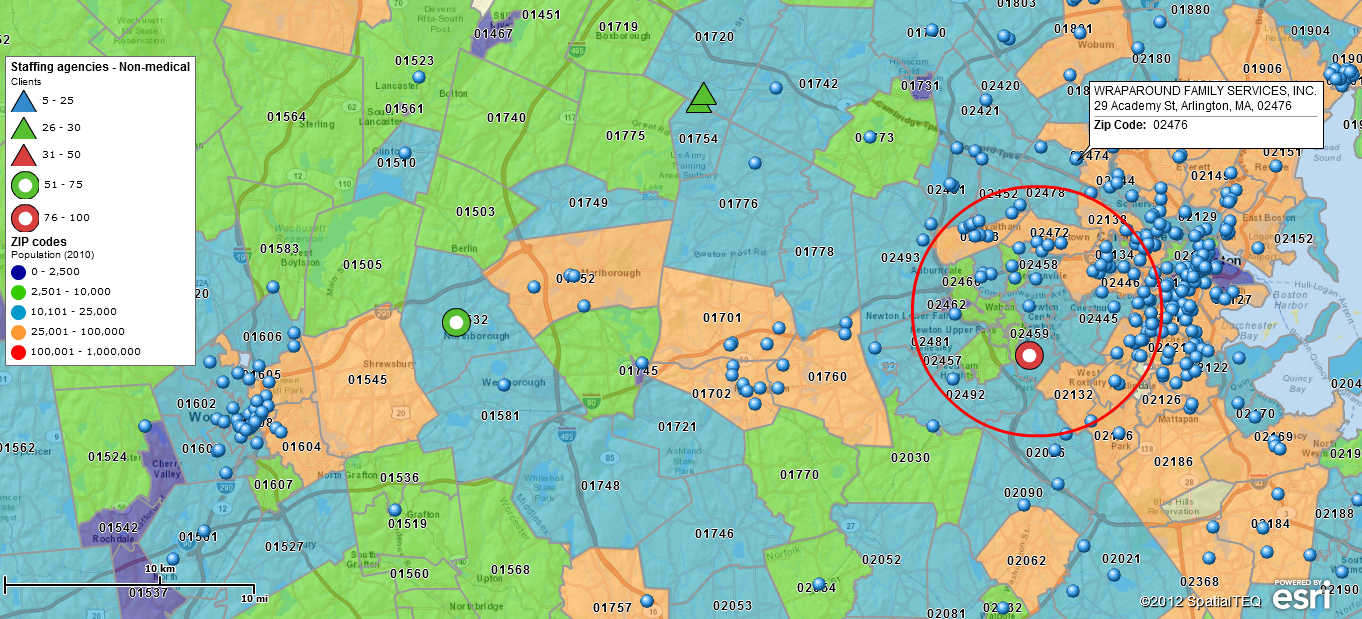“A map does not just chart, it unlocks and formulates meaning; it forms bridges between here and there, between disparate ideas that we did not know were previously connected.”
– Reif Larsen
Wikipedia defines Business Intelligence as “the ability of an organization to collect, organize and maintain knowledge that can be used to develop new opportunities.” Business Intelligence is information leveraged towards helping your business grow, defining new markets, reviewing the competition, or simply planning for the future. Business leaders often find Business intelligence can be more informative when visualized against a web-map, also referred to as location based services.
Available web-based map applications today offer much more than turn-by-turn directions. Business Intelligence begins with a visualization of critical business locations. Business web-maps enable easy web visualization of business spread sheets through standard import processes. The business manager can then visualize geocoded customer locations, prospects, and competition against an accurate base map or aerial image. Simple spatial search tools enable the geographic analysis of imported data providing valuable answers to questions like:
- How many prospects live along my business trip?
- How many medical businesses are located within 25 miles of the new hospital system?
- Visualizing retail tire sales, urban demographics, and local car sales, where should our next store should be located?
- Which sales people are responsible for expanding sales in specific zip-code territory areas?
Today there are many on-line and desktop map applications that offer simple and affordable options for viewing business intelligence against compelling map data. Business users no longer have to wait for maps, delayed by a long GIS software learning curve, befuddled by Google API’s, or buried in the to-do pile of the resident Map Geek. Smart managers now have ready access to cloud-based business intelligence map engines informing decisions around a variety of business processes:
Marketing – Simple spatial analysis tools or radius searches quickly define prospects by location and enable list segmentation by area. Users can then target mail/email campaigns by geographic area or proximity to a store location.
Sales Planning – Building effective territory designs that organize and direct your sales team are critical to managing a sales force. Sales managers use common geographic units, like zip-codes or counties, to identify areas of responsibility and to coordinate and track sales efforts. Efficient sales trips become a function of identifying where customers and prospects are located and estimating driving times between stops. Territories are adjusted to reflect the most effective use of a sales person’s time and to minimize travel costs, while improving accountability.
Event Planning – Sponsoring conferences and exhibitions is expensive. To maximize an organization’s return on investment planners seek to understand all they can about their target audience through demographic analysis. Web maps offer a unique perspective on the surrounding community. Event marketing campaigns can be directed to potential attendees based on where they live, the local population densities, and incomes for specific areas.
Site Selection/Expansion Planning – Where to invest in new locations is a common and critical decision for growing businesses. Maps provide visual confirmation supporting such decisions. Customers, prospects, competitors and critical local services are all easily identifiable on a map through simple geocoding. Supplemental business datasets showing sales, resources, or demographics by location can make expansion planning an exact science.
Supplementing map visualizations with additional data overlays expands business intelligence capabilities, further empowering critical decision making. Common map data supplements include Census Bureau data, NAICS Business data, CDC Health Care data, and a myriad of industry specific datasets available through free and paid for sources.
Once business managers begin applying location based services to business intelligence gathering new and powerful insights will lead to successful strategic planning. Map users will explore new and evermore enlightening perspectives on their business data. Locations based analysis provides opportunities to expose new patterns in everyday business activity that will suggest new business processes, changes in sales approaches, or simply untried markets to explore.
There’s a very good reason why companies like Google, Apple, Microsoft, and Amazon invest billions of dollars in basic web mapping functionality. Web-maps have rapidly become critical information sources informing business decision making and the development of business strategies. The use of web maps and location based services is both critical to business success and within the technical and budgetary reach of all businesses and organizations. Use these web maps to your advantage, or ignore them at your peril.
For maps: www.mapbusinessonline.com
Affordable business intelligence maps to inform your business, right now.
Author: Geoffrey Ives
Contact: geoffives@spatialteq.com (207) 939-6866

